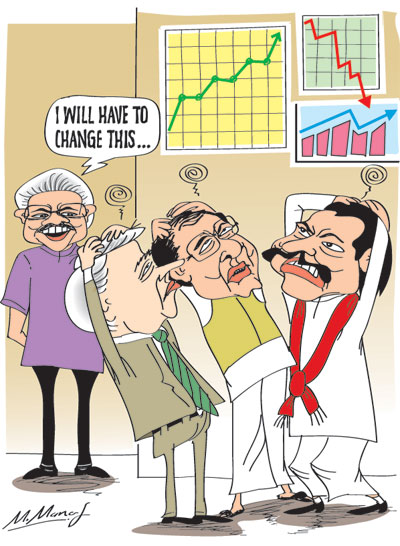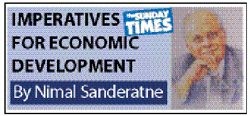Columns
State of Lankan economy as 21st Century’s ‘second decade’ (2010-2019) ends
View(s): It is appropriate to assess the country’s economic performance at year’s end and at the end of the second decade of the 21st century. Although December 31, 2019 is popularly considered the end of the second decade of the 21st Century, the second decade actually ends in 2020. However this misconception provides a useful periodisation to analyse the economic performance of the decade and the two regimes during the last ten years: the regime from 2010 to 2014 and the regime from 2015 to 2019.
It is appropriate to assess the country’s economic performance at year’s end and at the end of the second decade of the 21st century. Although December 31, 2019 is popularly considered the end of the second decade of the 21st Century, the second decade actually ends in 2020. However this misconception provides a useful periodisation to analyse the economic performance of the decade and the two regimes during the last ten years: the regime from 2010 to 2014 and the regime from 2015 to 2019.
 The decade
The decade
The second decade has been a decade when much was expected in the way of economic development, but too little was achieved. At the end of the decade, the country’s economic growth is low, macroeconomic fundamentals are weak and ridden with a large foreign debt.
However it would be incorrect to characterise the decade as a failure. It had its share of achievements as well. At the end of the decade, the country is a more developed one that has achieved the status of a high middle income country. No other South Asian country is in this income grouping.
Poverty has been brought down to less than 5 percent of the population and unemployment to 4.7 percent of the labour force. The country’s social indicators too have improved and the impressive achievements in human development of past decades have been improved on during this decade.
In spite of these achievements, Sri Lanka is the slowest growing economy in South Asia. Foreign debt is over US$ 55 billion that is about 65 percent of GDP, the fiscal deficit is about 6 percent of GDP and economic growth has tapered down to below 4 percent this year.
Economic growth
During the decade when two different regimes ruled the country, the economic performance was different. The economy grew at a much lower pace from 2015 to 2019 than in 2010-2014. Economic growth in the decade as a whole has been below expectations. This is especially so in the second half of the decade when it dipped to below 4 percent. In the first half of the decade the economy grew at an annual average of over 7 percent. At the end of the 5 years growth fell to 5 percent.
 Expectations
Expectations
The decade began with high expectations as the nearly three decade war ended in 2009. The country reaped a peace dividend as several sectors and subsectors of the economy that was disrupted by the war revived. This included agriculture in the North and East and border villages, fisheries in the North and East, tourism in the country and construction.
There was also an improvement in the business climate that increased investment somewhat. The law and order situation and a perception of an absence of the rule of law and the EU suspension of GSP Plus concession and sea food exports did not augur well for foreign investment.
Strengths and weaknesses
The economic growth in the first half of the decade had strengths and weaknesses. The strengths included the revival of significant economic activities and the improvement of infrastructure such as roads, bridges, fisheries harbours. These developments in infrastructure had immediate growth impacts as well as long term economic benefits.
The weaknesses were that the large infrastructure projects were foreign funded and increased the country’s foreign debt. Since these projects had an economic benefit over a long period of time and did not result in increased production of tradable goods, they became a debt burden. Furthermore some of the large foreign funded projects did not yield any returns. Consequently the country’s foreign debt increased sharply.
 Foreign debt
Foreign debt
Foreign debt had increased in the previous decade mainly due to large defence expenditure. The foreign debt that was only US$ 9 billion in 2000 increased to US$ 21.2 billion by the beginning of this decade (2010) owing to foreign borrowing for war expenditure.
There was a steep increase in foreign debt between 2010 and 2014. Foreign debt increased from US$ 21.2 billion in 2010 to US$ 42.9 billion in 2014. This increase in debt continued into the 2015 to 2019 period, partly due to repayment obligations requiring further foreign borrowing and fresh borrowing to meet expenditure on new projects. At the end of 2018 the foreign debt had reached US$ 54 billion. It is estimated at about US$ 56 billion at the end of 2019.
Fiscal deficit
A fundamental economic weakness has been the high fiscal deficits. The large infrastructure expenditure, increased public expenditures at election times and inadequate revenue collection were mainly responsible for the large fiscal deficits. These large fiscal deficits in turn weakened the macroeconomic fundamentals.
The decade witnessed four elections that resulted in extravagant populist expenditure that led to fiscal slippage. The fiscal deficit expanded due to the elections of 2010, 2014, 2015 and 2018.
The fiscal deficit increased from 5.7 percent in 2014 to 7.6 percent in 2015. There was an attempt to contain the fiscal deficit from 2016 by a revenue enhanced fiscal consolidation that achieved a degree of success mainly due to tax reforms that increased revenue. The fiscal deficit was contained at 5.4 and 5.5 percent of GDP in 2017 and 2018, respectively. However electoral pressures in 2019 resulted in fiscal slippage and the deficit this year is expected to exceed 6 percent of GDP.
Summing up
The second decade of the 21st century (2010-19) was one of high economic expectations, as it was ushered in after the end of the civil war. There was a post-war revival of the economy, but it tapered off in the second half of the decade to reach one of the lowest rates of economic growth.
The achievements of the decade were the substantial development of infrastructure, a rise in per capita incomes to the level of a high middle income country and the reduction of poverty and unemployment. The decade witnessed the bludgeoning of foreign debt to unsustainable levels, high fiscal deficits and external financial vulnerability.
Economic growth tapered off to one of the lowest rates of growth of below 4 percent. Most serious is the fundamental weakness of fiscal and external financial vulnerability. The country also witnessed several setbacks to the economy, especially in the second half of the decade. The constitutional anarchy in October 2018, the Easter Sunday attack in April 2019, the ethnic tensions that prevailed in the country, droughts floods and natural disasters and the distraction of elections slowed economic growth.
In brief, it was a decade when much was expected as it began after the end of the nearly 30-year civil war. The change of regime midway in the decade too gave rise to hopes and expectations that were not realised. At the end of the decade the country’s economic fundamentals are weak and the external financial vulnerability is high.


Leave a Reply
Post Comment